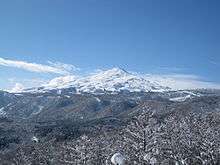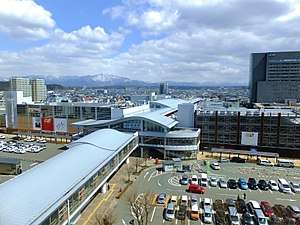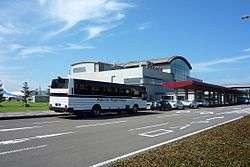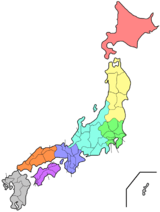Akita Prefecture
Akita Prefecture (秋田県, Akita-ken) is a prefecture of Japan located in the Tōhoku region of Honshu.[1] Its population is approximately 966,000 (as of 1 October 2019) and its geographic area is 11,637 km² (4,493 sq mi). Akita Prefecture borders Aomori Prefecture to the north, Iwate Prefecture to the east, Miyagi Prefecture to the southeast, and Yamagata Prefecture to the south.
Akita Prefecture 秋田県 | |
|---|---|
| Japanese transcription(s) | |
| • Japanese | 秋田県 |
| • Rōmaji | Akita-ken |
 Flag  Symbol | |
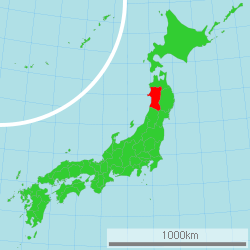 | |
| Country | Japan |
| Region | Tōhoku |
| Island | Honshu |
| Capital | Akita (city) |
| Subdivisions | Districts: 6, Municipalities: 25 |
| Government | |
| • Governor | Norihisa Satake |
| Area | |
| • Total | 11,637.52 km2 (4,493.27 sq mi) |
| Area rank | 6th |
| Population (October 1, 2019) | |
| • Total | 966,000 |
| • Rank | 38th |
| • Density | 83/km2 (210/sq mi) |
| ISO 3166 code | JP-05 |
| Website | Akita Prefecture Official page of English |
| Symbols | |
| Bird | Copper pheasant (Phasianus soemmerringii) |
| Flower | Fuki (a kind of butterbur, Petasites japonicus) |
| Tree | Akita-sugi (Cryptomeria japonica) |
Akita is the capital and largest city of Akita Prefecture. Other major cities include Yokote, Daisen, and Yurihonjō.[2] Akita Prefecture is located on the coast of the Sea of Japan and extends east to the Ōu Mountains, the longest mountain range in Japan, at the border with Iwate Prefecture. Akita Prefecture formed the northern half of the historic Dewa Province with Yamagata Prefecture.
History
The region of Akita was created from the ancient provinces of Dewa and Mutsu.[3]
Separated from the principal Japanese centres of commerce, politics, and population by several hundred kilometres and by the Ōu and Dewa mountain ranges to the east, Akita remained largely isolated from Japanese society until after the year 600. Akita was a region of hunter-gatherers and principally nomadic tribes.
The first historical record of what is now Akita Prefecture dates to 658, when Abe no Hirafu conquered the native Ezo tribes at what are now the cities of Akita and Noshiro. Abe, then governor of Koshi Province (the northwestern part of Honshū bordering the Sea of Japan), established a fort on the Mogami River, and thus began the Japanese settlement of the region.
In 733, a new military settlement (later renamed Akita Castle) was built in was is now the Takashimizu area of Akita, and more permanent roads and structures were developed. The region was used as a base of operations for the Japanese empire as it drove the native Ezo people from northern Honshū.
Governance of the region shifted hands several times. During the Tokugawa shogunate it was appropriated to the Satake clan, who ruled the region for 260 years and developed the agriculture and mining industries that are still predominant today. Throughout this period, it was classified as part of Dewa Province.[1] In 1871, during the Meiji Restoration, Dewa Province was reshaped and the old daimyō domains were abolished and administratively reconstructed, resulting in the modern-day borders of Akita.
The famous Heian period waka poet, Ono no Komachi, is said to have been born in Yuzawa City, Ogachi Town, located in the southeast of the prefecture.
Geography
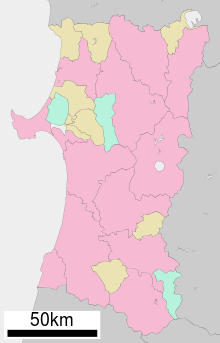
City Town Village
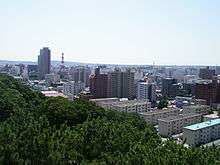
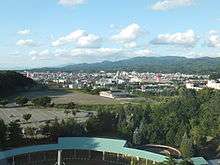
| Year | Pop. | ±% p.a. |
|---|---|---|
| 1872 | 582,297 | — |
| 1880 | 618,833 | +0.76% |
| 1890 | 697,298 | +1.20% |
| 1903 | 837,665 | +1.42% |
| 1913 | 943,628 | +1.20% |
| 1920 | 898,537 | −0.70% |
| 1925 | 936,408 | +0.83% |
| 1930 | 987,706 | +1.07% |
| 1935 | 1,037,744 | +0.99% |
| 1940 | 1,052,275 | +0.28% |
| 1945 | 1,211,871 | +2.86% |
| 1950 | 1,309,031 | +1.55% |
| 1955 | 1,348,871 | +0.60% |
| 1960 | 1,335,580 | −0.20% |
| 1965 | 1,279,835 | −0.85% |
| 1970 | 1,241,376 | −0.61% |
| 1975 | 1,232,481 | −0.14% |
| 1980 | 1,256,745 | +0.39% |
| 1985 | 1,254,032 | −0.04% |
| 1990 | 1,227,478 | −0.43% |
| 1995 | 1,213,667 | −0.23% |
| 2000 | 1,189,279 | −0.41% |
| 2005 | 1,145,501 | −0.75% |
| 2010 | 1,085,997 | −1.06% |
| 2015 | 1,074,858 | −0.21% |
| source:[4] | ||
Located in the north of Honshu, Akita Prefecture is adjacent to the Sea of Japan to the west and borders four other prefectures: Aomori in the north, Iwate in the east, Miyagi in the southeast, and Yamagata in the south.
The borders of Akita Prefecture roughly form a rectangle that is 169 kilometres (105 miles) from north to south and 86 kilometres (54 miles) from west to east. The Oga Peninsula is a prominent feature of the western edge, while the Ōu Mountains mark the eastern border and the higher Dewa Mountains run parallel through the center. Like much of northern Japan, the prefecture has cold winters, particularly in areas farther from the sea.
As of 31 March 2019, 11% of the total land area of the prefecture is designated as Natural Parks, namely the Towada-Hachimantai National Park; Chōkai, Kurikoma, and Oga Quasi-National Parks; and Akita Shirakami, Hachimori Iwadate, Kimimachizaka, Magi Mahiru, Moriyoshizan, Taiheizan, Tashirodake, and Tazawako Dakigaeri Prefectural Natural Parks.[5][6]
Cities
Thirteen cities are located in Akita Prefecture:
Towns and villages
These are the towns and villages in each district:
Mergers
List of Governors of Akita Prefecture (from 1947)
| Nº | Name | Term start | Term end | Notes (political party) |
|---|---|---|---|---|
| 1 | Kosaku Hasuike (蓮池公咲) | 12 April, 1947 | 4 April, 1951 | Akita Prefecture Democratic Party (秋田県民主党) |
| 2 | Tokuji Ikeda (池田徳治) | 30 April, 1951 | 29 April, 1955 | Independent (無所属) |
| 3 | Yujiro Obata (小畑勇二郎) | 30 April, 1955 | 29 April, 1979 | Independent |
| 4 | Kikuji Sasaki (佐々木喜久治) | 30 April, 1979 | 31 March, 1997 | Independent |
| 5 | Sukeshiro Terata (寺田典城) | 20 April, 1997 | 19 April, 2009 | Independent |
| 6 | Norihisa Satake (佐竹敬久) | 20 April, 2009 | Present | Independent |
Economy and Population
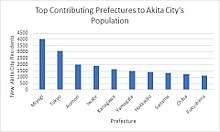
Like much of the Tōhoku Region, Akita's economy remains dominated by traditional industries such as agriculture, fishing, and forestry. This has led many young people to migrate to Tokyo and other large cities. Akita Prefecture has seen some of the most severe population decline in Japan: it is one of four prefectures in Japan registering declines in population since 1955. Its population also has the lowest percentage of children, at 11.2%.[8] As of October 1, 2019, it has a population of approximately 966,000 people.[9]
The high rate of depopulation in Akita Prefecture has led smaller communities to merge with each other, which has affected the smallest of these merged communities. As depopulation in these communities continues, educational and health facilities have closed in some areas, encouraging families to migrate to larger cities for better access to health and educational opportunities and perpetuating the decline in population. This decline, combined with an aging population, has been concerning for rural communities.[7]
Culture
Akita is famous for rice farming and its sake breweries.[10] It is well known for having the highest consumption of sake in Japan[11] and is thought to be the origin of the Akita breed of dog which carries the prefecture's name. The women of the region, referred to as Akita bijin (秋田美人, 'beauties of Akita'), have also gained widespread renown for their white skin, rounded faces and high voices, all of which are considered highly desirable.[12] Ono no Komachi is a famous example of an Akita bijin.
Food
Akita is known for the following regional specialties (tokusanhin):
Sports
- Akita Northern Happinets, men's basketball team.
- Akita Bank Red Arrows, women's basketball team.
- Prestige International Aranmare Akita, women's basketball team.
- Akita Northern Bullets, rugby union team.
- Blaublitz Akita, association football team.[14]
Tourism

Recently there have been efforts to revitalize rural communities facing depopulation with different forms of green tourism and agritourism.[15] These efforts are primarily aimed at attracting urbanites and foreign tourists to Akita Prefecture, advertising its pristine forests, sprawling rice fields, and range of cultures.[7] There has been a push for home stays, farmers markets for locally produced foods, and the integration of outsiders into local cultural practices. The Namahage ritual in Oga on New Year's Eve draws a large number of tourists to Akita Prefecture every year.[16]
Near Lake Tazawa, there are a number of hot springs resorts (onsen). These are popular with tourists from all over Japan. In addition, numerous seasonal festivals (matsuri) offer a glimpse of rural or traditional Japan. Some famous examples are the Akita Kantō, the Omagari Fireworks, Namahage Festival, and the Yokote Kamakura Festivals.
Kakunodate, known as the little Kyoto, features many preserved samurai houses. The Aoyagi house is the former residence of Odano Naotake, who illustrated Japan's first modern guide to human anatomy. The house is now a museum and gallery of medical illustrations and traditional crafts.
Starting in 2009, Akita began experiencing a huge surge in Korean tourism after the airing of the popular drama Iris, which featured several scenes shot in Akita, most notably at Lake Tazawa and Oga's GAO Aquarium.[17]
Famous festival and events
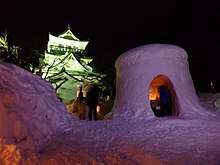
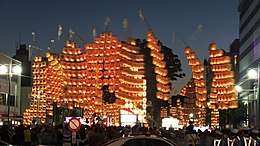
- Kariwano Big Tug Festival, Daisen (February[18])
- Amekko Festival, Odate (February[19])
- Kamakura Snow Statue Event, Yokote (February[20])
- Tsuchizaki Shinmei Festival, Akita (July)
- Akita Kanto Festival, Akita (August)
- Nishimonai Bon Dancing Festival, Ugo (August[21][22])
- Kemanai Bon Dancing Festival, Daisen (August[23])
- All Japan Firework Competition, Daisen (August[24])
- Kakunodate Festival, Semboku (September)
Transportation
Railroads
- JR East
- Akita Trans Inland Railway (Akita Nairiku Jyukan Railway)
- Yuri Plateau Railway (Yuri Kogen Railway)
Roads
Expressways
- Akita Expressway
- Nihonkai-Tohoku Expressway
- Tohoku Expressway
- Yuzawa-Yokote Road
National Highways
- Route 7 (-Nikaho-Yurihonjō-Akita-Katagami-Ikawa-Gojōme-Hachirōgata-Mitane-Noshiro-Kitaakita-Ōdate-)
- Route 13 (-Yuzawa-Yokote-Misato-Daisen-Akita)
- Route 46 (-Semboku-Daisen-Akita)
- Route 101 (-Happō-Noshiro-Mitane-Oga-Katagami-Akita)
- Route 103 (-Kosaka-Kazuno-Ōdate)
- Route 104 (-Kazuno-Ōdate)
- Route 105 (Yurihonjō-Daisen-Semboku-Kitaakita)
- Route 107 (-Yokote-Yurihonjō)
- Route 108 (-Yuzawa-Yurihonjō)
- Route 282 (-Kazuno-Kosaka-)
- Route 341 (Kazuno-Semboku-Daisen-Akita-Yurihonjō)
- Route 342 (Yokote-Higashinaruse-)
- Route 397 (-Higashinaruse-Yokote)
- Route 398 (-Yuzawa-Ugo-Yurihonjō)
- Route 454 (-Kazuno-Towada, Aomori-Kosaka-)
Education
Universities in Akita Prefecture
Media
Television
- NHK Akita Broadcasting (NHK)
- Akita Asahi Broadcasting (AAB)
- Akita Broadcasting System (ABS)
- Akita Television (AKT)
Notes
- Nussbaum, Louis-Frédéric. (2005). "Provinces and prefectures" in Japan Encyclopedia, p. 780, p. 780, at Google Books; "Tōhoku" in p. 970, p. 970, at Google Books.
- Nussbaum, "Akita" in p. 20, p. 20, at Google Books.
- Nussbaum, "Provinces and prefectures" in p. 780, p. 780, at Google Books
- Statistics Bureau of Japan
- 自然公園都道府県別面積総括 [General overview of area figures for Natural Parks by prefecture] (PDF) (in Japanese). Ministry of the Environment. Retrieved August 17, 2019.
- 秋田の自然マップ [Akita Nature Map] (in Japanese). Akita Prefecture. Retrieved August 17, 2019.
- Quinones, C. Kenneth. “Chapter 2: Akita City.” Akita-Beyond the Road's Narrow End, Mineo Nakajima, 2011, pp. 26–27.
- "Number of children in Japan falls to record low for 29th year in row". The Japan Times. Kyodo News. May 4, 2010. Archived from the original on June 6, 2011. Retrieved May 26, 2011.
- Population Estimates / Annual Report (Report). e-Stat. April 14, 2020. Retrieved May 9, 2020.
- Omura, Mika (November 6, 2009). "Weekend: Sake breweries go with the flow to survive". Retrieved December 29, 2009.
- The Appellation System for Sake in Akita Prefecture and Development Program for Akita Shun-ginjo, Kyuichi Saito, Journal of the Brewing Society of Japan; Vol. 87, No.11, 1992 Archived June 16, 2007, at the Wayback Machine
- "Akita Prefecture - Culture, Sightseeing and History -". nihonscope.com. August 24, 2016. Retrieved March 25, 2018.
- Akita Prefectural Guide, AKITA Prefecture Archived January 17, 2011, at the Wayback Machine
- http://www.blaublitz.jp/
- Sznajder, Michal, Przezborska, Lucyna, Scrimgeour, Frank, et al. “Agritourism.” AbeBooks, CABI, 1 Jan. 1970, www.abebooks.com/book-search/isbn/9781845934828/.
- Foster, Michael Dylan. “Inviting the Uninvited Guest: Ritual, Festival, Tourism, and the Namahage of Japan.” Journal of American Folklore, American Folklore Society, 1 Aug. 2013, muse.jhu.edu/article/515294/pdf.
- 笠井 (Kasai), 哲也 (Tetsuya); 矢島大輔 (Yajima Daisuke) (April 21, 2010). 韓国人ファン、秋田に殺到 ドラマ「アイリス」効果. Asahi Shimbun (in Japanese). Japan. Archived from the original on April 23, 2010. Retrieved April 22, 2010.
- "刈和野の大綱引き" (PDF) (in Japanese). Daisen City. Archived from the original (PDF) on November 27, 2015. Retrieved November 26, 2015.
- "大館アメッコ市 - 秋田県大館市" (in Japanese). Odate City. Retrieved November 26, 2015.
- "(冬)横手のかまくら|横手市" (in Japanese). Yokote City. Retrieved November 26, 2015.
- "総合案内|羽後町" (in Japanese). Ugo Town. Retrieved November 26, 2015.
- "English|羽後町". Ugo Town. Retrieved November 26, 2015.
- "毛馬内の盆踊" (in Japanese). Kazuno City. Archived from the original on November 26, 2015. Retrieved November 26, 2015.
- "全国花火競技大会「大曲の花火」オフィシャルサイト|大曲商工会議所" (in Japanese). Omagari Entrepreneurs Group. Retrieved November 26, 2015.
References
- Nussbaum, Louis-Frédéric and Käthe Roth. (2005). Japan encyclopedia. Cambridge: Harvard University Press. ISBN 978-0-674-01753-5; OCLC 58053128
External links
| Wikivoyage has a travel guide for Akita (prefecture). |
![]()
